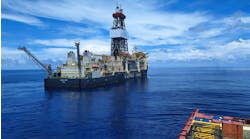David Liddle
ITF
Implementation of new technologies can be critical to development of marginal fields. This is also the case on fields reaching maturity and requiring increased support to sustain production.
SWIT (subsea water injection and treatment) is a new process which fulfils these demands by removing the need for heavy, labor-intensive water treatment and injection equipment on a platform, and instead placing it on the seabed.
The concept has undergone several phases of development since its origin in 2002. A full-scale SWIT pilot plant has recently completed a successful year’s operation on the sea floor in a Norwegian fjord with the help of global technology funding program, ITF (Industry Technology Facilitator). The technology now is ready for full field applications.
Deployment of the SWIT pilot plant to the sea floor.
ITF is a UK-based, not-for-profit organization that acts as a broker between technology developers and its members, which currently comprise 25 major oil and gas operators and service companies. To date, ITF has secured over £50 million ($77 million) of funding from its members resulting in the launch of more than 150 joint industry projects.
A total of £1.4 million ($2.16 million) was committed to development of the SWIT, much of this coming from ITF’s members and the Norwegian Research Council. The concept was conceived by Dave Pinchin, chief technology officer at Well Processing, to use the inherent advantages of a seabed installation including water quality and power savings. The equipment is designed to be an all-electric, autonomous system that can be fed via a power/control cable from any suitable source.
The component parts were sourced from subsea manufacturers in countries including Norway, Sweden, Germany, and the UK. Equipment assembly was by HighComp, a specialist supplier of fiberglass subsea protection covers.
Reservoir management
Water injection from a typical topsides platform brings restrictions such as the number of injection wells, weight, and space available for the treatment plant. Subsea water injection provides more freedom in terms of the number and location of injection wells.
The SWIT system is designed to supply high-quality, treated water to an injection pump for use in water injection wells. The operator can introduce as much treated seawater as necessary, wherever required, at any stage of a field’s life. SWIT, therefore, enables reservoir engineers to re-think a field’s reservoir drainage strategy and to manage the reservoir more effectively, ultimately getting more oil out.
SWIT extracts water from the seabed area, where there are inherent advantages such as less bacterial concentration. A combination of residence time within a “still room” plus three steps of electrochemical and chemical dosing provides disinfection and solids reduction.
Step one is electrochlorination, which has been applied in topsides water treatment systems for many years. With SWIT, the technique has been marinized to provide robust and controllable generation of sodium hydrochloride from incoming salt water by electrolysis. A lengthy residence time within the “still room” allows for a maximum chlorine-to-seawater ratio and contact time.
The next step is innovative. SWIT employs diamond-coated electrodes that preferentially generate hydroxyl radicals. These radicals kill remaining bacteria or other organic matter in the water to be injected.
The final step involves the injection of biocide, a chemical used regularly to control the formation of biofilms, which may remain after the first two steps. Testing shows that the rate of biofilm build-up is significantly less than with “raw” seawater, hence less biocide is required than with a topsides system.
To maximize the interval between biocide chemical replacements, SWIT can apply concentrated forms of chemicals such as solids and gels that are built into replaceable containers.
On traditional topsides facilities, regular deliveries of liquid biocide are often bulky, expensive, and time consuming to load on and off the platform deck. In addition, with SWIT offshore personnel do not need to handle the biocide or sodium hydrochloride chemicals when these fluids are delivered offshore.
The biocide dosing container together with the electrochlorination and hydroxyl radical generator units are assembled in a replaceable treatment cartridge placed within the SWIT still room. Testing shows that the treatment cartridge lifetime can be designed to meet a subsea operators’ intervention interval requirement.
Test results
The SWIT full-scale pilot plant is a world first in treatment of seawater on the seabed. The plant, first deployed offshore in July 2009, has successfully completed a full year’s operation. The equipment was installed at Oslofjord, just south of Drøbak.
Treated seawater produced from the pilot plant is transferred to NIVA (the Norwegian Water Research Institute) for analysis. This is because it is difficult and not cost effective to get pilot equipment tested offshore.
Results show that the system has a significant effect on delaying the formation of biofilm, excellent disinfectant results, and a continuous reduction in solids content. The inherent simplicity of the treatment system enables a 99.7% uptime compared with a topsides water treatment plant norm of 85-95%.
The next step is to test the treatment side as we have proven the technology that deals with water injection. The pilot enabled flows from 25-100 cu m/hr (883-3,531 cu ft/hr). Designs have been considered for flow rates of up to 3,000 cu m/hr (105,944 cu ft/hr).
Economic evaluations show that cost reductions of between 30-50% would be achieved with SWIT compared to topside treatment plants. This can be attributed to a simpler treatment system, consumption of 20% less power, and a reduction in the use of water treatment chemicals, which also should benefit the environment.
SWIT has potential applications in the Middle East, Far East, North Sea, and the Gulf of Mexico. It is also being considered for large land-based reservoirs such as those around the Arabian Gulf.
Offshore Articles Archives
View Oil and Gas Articles on PennEnergy.com




